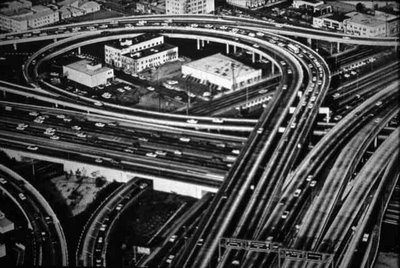
A few months ago, Pruned ran an excellent piece about farms for cloned meat. There, inside huge barns, rubbery mats of cloned muscle – stretched lumps of unBeef® – would vibrate, growing, pulsing, often ripping, beneath a steady stream of jelly-like vitamin wash. Nutrients would slide across those gleaming, fat-marbled surfaces... clumped and soapy.
A handful of underpaid Mexican night-workers would then come through with industrial strength pizza cutters, chopping the meat-sheets into rectangular blocks.
You would then buy one of those blocks, intending for your own kids to chew it and swallow it. This would be called "feeding them steak."
"Chicken."
"Pork."

But what really interests me here is whether such a scenario might pose a new future for landscape design.
What if someone were to develop, for instance, a kind of organic bio-paving for the world's freeways, replacing asphalt? In which case: could you clone whole stretches of interstate? Cloverleaf junctions, skyways, off-ramps?
Would summer road crews perform something more akin to skin-graft operations? Stretching huge films of living matter over the world's dual carriageways. Minimal surfaces.
And so on.

[Image: Frei Otto's architecture of minimal surfaces].
The risk, of course, would be that there's some fatal, unknown flaw in your cloning technique and so, one day, the freeways wake up. They shake themselves free from the dirt and filth; they tuck their herniated loops of distant traffic circles up underneath themselves; and they walk away...

All of LA's sprawling anatomy of freeways and cloverleaf junctions arises with a tectonic shiver from the arid sands of southern California, artificially intelligent, blinking with traffic lights, and it wanders free into the American desert. Shining. A kind of moving, hyperdimensional squid made of asphalt and miswired traffic control programs shambling into the mountains, raining cars.
No comments:
Post a Comment